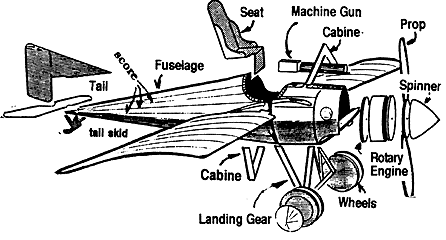



Morane-Saulnier N Bullet WWI French Scout
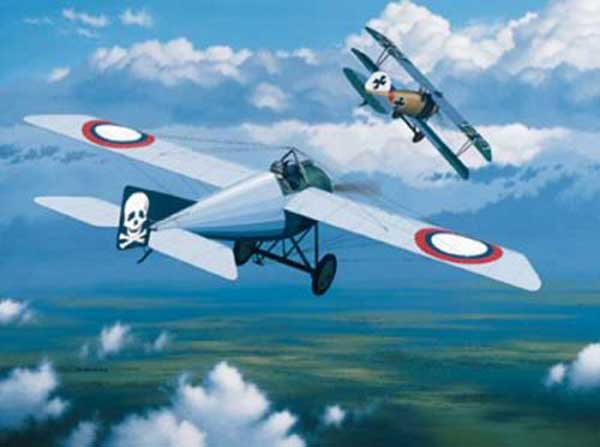
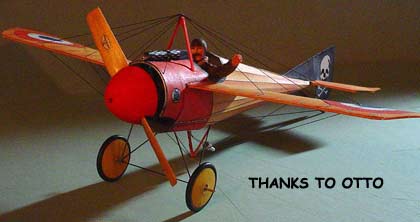
Morane-Saulnier 'N' Bullet was a very early single winged scout(1914) that evolved from a racing aeroplane day.
Great for racing but disastrous as a Scout because pilots were so preoccupied with worry about landing the darn thing, they found it impossible to concentrate on the fighting.
The Bullet was one of the first airplanes to have a gun that could, almost always, fire through the propeller.
Look for the little bullet deflectors on the model's propeller.
|

What people say...
"The prop isn't turning, that's why the pilot jumped out, overlooking the minor fact that the parachute had not yet been invented in 1914. Peter Dobrynine, Brussels
Great Russian Imperial Air Force Moraine-Saulnier model! This has always been my favorite WW-I aircraft. When I was a kid, I found a picture of Russian Ace Captain Karamazoff's M-S in one of my dad's books. I built it from plans I drew myself when I was able to locate the dimensions. Rubber powered, it even flew! Thanks for this one Jim Krasnansky Seward, Alaska
Wow- re-pirating a pirated model of your own. Does that make you a Privateer?
Having now built most of the free downloads, I found the
Morane-Saulnier Bullet the most fun to date! With brown
thread,the rigging almost sings in the wind without moving
an inch! The layout and reference page really helped in
placing the wing "wires". I used an adaptation of my straight pin-as-propeller-shaft
idea, inspired by another cardmodelling source, to get a
true rotating Le Rhone rotary engine. As the fuselage is
assembled, a straight pin is pushed through the center,
from the rear, of the forward engine-mount disk that forms
the nose of the fuselage. I pre-poked centered pinholes
through both "plates" of the engine itself, and through
the center of the propeller and plate hub. The entire engine/propeller
assembly is glued together as a unit, and put onto the shaft
of the pin before the addition of the spinner. Once on,
a cardstock disk (in hindsight, this was probably unnecessary),
was cut and pushed on over the propeller hub, then glued
in place. The pin was then cut short with a pair of wire
cutters, to be short enough not to interfere with the spinner.
Now, just like the original, the entire engine rotates when
the propeller spins!...Marty V
I downloaded the Morane-Saulnier Bullet awhile back and showed it to some other model airplane hobbyist. All were impressed, the graphics are great and if this works like I hope it does, you should expect more orders. I'll be sure to pass on what a pleasure it is to deal with Fiddler's Green. Thank you again. Tracy
Thought you would get a kick out this. I put together the Moran with some modifications, Turned balsa spinner, wire landing gear, turned wood wheels, o-ring tires, a couple of wood bulkheads, a carved and painted balsa pilot and then powered it with a Gasparin G-10 (10 cubic millimeter displacement ) co2 motor. The result was a phenomenal flying machine. I've had many, many flights averaging well over 1 minute and the best flight was 2 minutes 13 seconds.
Unfortunately it met with disaster, for me at least. The last flight, due to prevailing air currents, it landed over a ridge a great distance from the launch point. Before we could get to it, according- to witnesses:), two young kids ran off with it. Never saw it again. I'm making another one at the present time. I plan to make more of your models, co2 powered. One bit of irony The little Moran that flew so well will never fly again as the kids have not means nor knowledge to even fill the fuel tank. Otto Kuhni (see model above)
MORANE-SAULNIER N
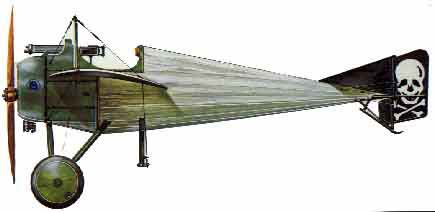
The Type N or Monocoque-Morane was a mid-wing monoplane powered by the 80 h.p. Gnome or 110 h.p. I. Rhone engine. The airscrew had a large spinner, named 'la casserole', which left only a small annular opening for cooling the engine, so that it was often discarded in hot weather. The typical Morane wings were of wood and fabric construction with flexible tips to allow for warping. The fuselage was not a true monocoque; its circular section was formed by fitting light stringers over a wooden frame A balanced elevator was fitted the triangular fin and plain rudder were of low aspect-ratio. Like most of the Morane types, the undercarriage struts were of 'M' shape when viewed in front elevation.
Early in 1914 Raymond Saulnier devised a true synchronizing gear, using a Hotchkiss gun borrowed from the French Army. Difficulties were caused by the faultiness of the standard ammunition supplied, and Saulnier replaced his gear with a crude arrangement of steel deflectors fixed to the airscrew blades; those bullets which did not pass between the blades were deflected by the steel plates. On the outbreak of war, the idea was temporarily abandoned.
Among the well-known pre-war pilots serving with
Escadrille MS. 23 early in the w ar was Roland Garros. The unit
commander, Capitaine de Vergnette, on his own initiative sent
Garros to Villacoublay to co-operate with Saulnier. In March
1915 Garros returned with a Morane N armed with a fixed Hotchkiss
gun capable of firing through the airscrew arc. Deflector plates
were fitted to the airscrew blades. A German two-seater was
shot down in flames on April 1st, 1915, and other victories
followed on the 13th and 18th of the same month. The next day
he forced-landed on the wrong side of the lines, and the device
fell into German hands. As a direct result of this capture,
the Fokker synchronizing gear was developed.
ar was Roland Garros. The unit
commander, Capitaine de Vergnette, on his own initiative sent
Garros to Villacoublay to co-operate with Saulnier. In March
1915 Garros returned with a Morane N armed with a fixed Hotchkiss
gun capable of firing through the airscrew arc. Deflector plates
were fitted to the airscrew blades. A German two-seater was
shot down in flames on April 1st, 1915, and other victories
followed on the 13th and 18th of the same month. The next day
he forced-landed on the wrong side of the lines, and the device
fell into German hands. As a direct result of this capture,
the Fokker synchronizing gear was developed.
Other French pilots quickly obtained Morane single seater's; the N was flown by Navarre, the first French ace and by Pegoud, the pre-war exhibition pilot who shot down six cumny aeroplanes before being killed on August 31st, 1915. Later machines were armed with a synchronized Vickers gun.
The British purchased a few Ns, which were used b Nos. 3 and 60 Squadrons, R.F.C., during the summer of 1916. The type became known as the 'Bullet' in the R.F.C.; it was armed with a Lewis gun. Ns were a1so supplied to the Russian 19th Squadron.
A captured Fokker monoplane (probably an E-III) and a 'Bullet' were flight-tested together in April 1916, and the Morane was found to have the better performance. It was not an airplane for a beginner, however, having very high landing speed and extreme fore-and-aft sensitivity.
Some Monocoque-Morane's had strengthened under carriages, modified cowlings and smaller spinners. The N and AC were 1916 developments; some thirty of the latter type were constructed, but it is doubtful if it formed the equipment of any operational unit. The wings were strut braced from below.
|
THE MORANE SAULNIER 'N' (BULLET) If there was one single overriding consideration
in aircraft construction during the First World War, it
was the quest for aeroplanes that could fly higher, faster,
farther, and could lift greater payloads. There were basically
three ways in which this could be done: By streamlining
and making it aerodynamically cleaner, by lightening it,
and by increasing engine power. For the most part the
third of these options was the one most commonly used
except as in the case of the Bullet. Incredibly, its empty
weight was only 635 lb and its loaded weight was 981 lbs.*
The 'N with its circular section fuselage and huge domed
spinner was more aerodynamic-ally advanced than any airplane
that flew in the entire war! The 49 "N's that were built were used by the French Air Force, RAF and the Russian Air Service. The real reason for this aeroplane's place in aviation history (and how it changed fighter design for all time) is the fact that Raymond Saulnier had invented a rudimentary synchronizing gear for machine guns enabling the gun to shoot between revolving blades of the propeller. |
There was one catch, however, the service ammunition was not of high quality, and occasionally delayed in firing just long enough to hit one of the blades. So he also installed steel deflectors with the idea that they would take care of any bullet that didn't pass between the blades.. The soon to be famous French fighter pilot Roland Garros achieved several victories in quick succession before being forced down behind the lines with engine trouble. Anthony Fokker copied and improved the concept and within days the Germans were installing synchronizing gear on the Fokker EIII Eindecker's. *For comparison, the SPAD XIII, the fighter with which the Allies finished up the war, weighted 1,255 lb empty and 1,808 lb loaded. Construction Tips! The Morane-Saulnier Bullet was a very early single winged scout (1914) that evolved from a racing aeroplane of the day. Great for racing but disastrous as a Scout because pilots were so pre-occupied with worry about getting back down. The Bullet was the first aeroplane to have a gun that could, more or less, fire through the propeller. |
Military aviators in every country worked on the problem of using a machine gun in the air. One of them was Roland Garros, who became the first real combat pilot of World War I.
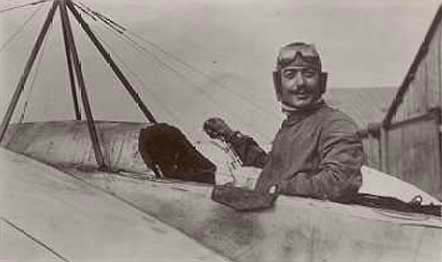
Garros had already won fame as a flier when he joined one of the first observation squadrons to be organized by the French. A former student of the piano, Garros had originally gone to Paris to complete his musical education. There he saw his first airplane and before long the piano was forgotten. Garros persuaded the famous Brazilian airplane designer, Alberto Santos-Dumont, to teach him to fly. He proved an apt pupil; soon he was one of the best fliers in France. Garros took part in air races and made exhibition flights in Europe and in the United States. In 1913 he became the first man to fly across the Mediterranean Sea. The 453-mile trip from southern France to Tunisia took him a little less than eight hours.
On the day war was declared Garros was in Germany, where he had been giving exhibition flights. As a French citizen he faced arrest as an enemy alien. Fortunately, in the excitement caused by the war declaration, neither Garros nor his plane was closely guarded. He was able to take off that night and fly back to France. (Very few people had ever attempted to fly at night.) In addition, he managed to take off without the help of the several Germans who had made up his ground crew.

On his return to Paris, Garros reported for military service. Soon he was flying above the advancing German army, checking on its strength and location. And he began to think about ways of using a gun in the air. He felt that a pilot should be able to reach his gun easily and fire it directly forward. In other words, he should be able to aim his plane at the enemy and shoot.
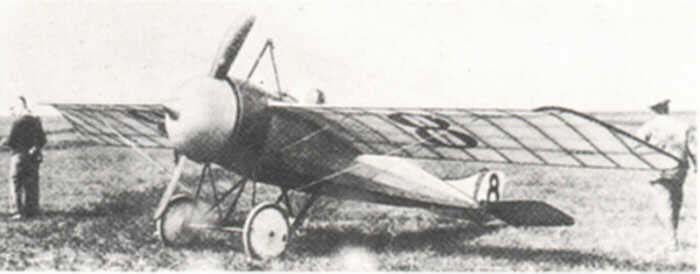
But what about the propeller? Garros had heard that a French flier named Eugene Gilbert had tried wrapping the propeller blades with steel-wire tape to deflect the bullets that struck them. While Gilbert was experimenting with this idea, ricocheting bullets killed two men who were helping him. So the project was abandoned.
Garros figured that less than seven percent of the bullets he fired would strike the propeller. To guard against accidents from that seven percent, he designed triangular metal shields for the back of the propeller blades. The shields were angled to deflect bullets away from the plane and the pilot.
Garros started work on his forward-firing gun in February, 1915. On April 1 he was ready to take such a gun, mounted behind the propeller and fitted with steel deflector pieces, into the air against the enemy. He flew a French Morane-Saulnier biplane, since his regular Morane-Saulnier monoplane was not in working order that day.
Soon after take-off, Garros spotted four German two-place Albatros observation planes heading for the French lines. He caught up with them, turned into the nearest one, and fired. A burst of machine-gun bullets flew through his whirling propeller, and the Albatros went down. Garros ended his pass in a dive but he quickly regained altitude. Once more, flames sparkled brightly between his propeller blades; a second Albatros exploded in midair. The two surviving Albatros pilots headed for home at full throttle.
For the next two weeks Roland Garros flew his Morane over the battleground. His forward-firing gun shot down five German planes, and he became the first Allied ace of World War I.
At that time "ace" was a word applied to anyone who accomplished something outstanding. The man who won a bicycle race was an ace. So was the soldier who performed an act of special bravery. But when the newspapers began to carry numerous stories about "that ace among pilots, Roland Garros," and the planes he had downed, the word acquired a new meaning. An ace was a pilot who shot down five planes.
Garros and his Morane caused considerable consternation
among German pilots and observers. Those who saw him in action
reported: "He seems to be firing between the blades of his
propeller, b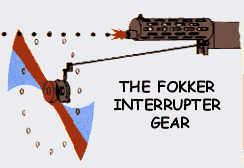 ut that is impossible."
ut that is impossible."
Impossible or not, Garros' bullets were finding their mark. German pilots became very cautious about flying where they might meet up with the deadly French monoplane. Then on April 19 engine trouble forced Garros down behind the German lines. Pilots on both sides were under instructions to burn their planes if they came down in enemy territory. It was especially important that the Morane be destroyed because of the secret shield on the propeller. If the Germans learned about it, they too could fire a gun through propeller blades.
The Morane wouldn't burn. The plane was wet and nothing the frantic Garros could do would set it afire. The French flier was taken prisoner, but his plane received more attention from his captors than he did. It was taken to Berlin where Anthony Fokker, a Dutch airplane designer working in Germany, was asked to take a look at the shield on the propeller blades.
"We would like you to work out something like this for our planes," the German generals told Fokker. Anthony Fokker, who had a quick, scientific mind, realized at once that he must try to do more than copy Garros' idea.........
MORANE-SAULNIER N
By 1913 monoplane design had reached a very high level in France, and the Deperdussin and Morane single-seaters of that year were remarkably well streamlined.
The Type N or Monocoque-Morane was a mid-wing monoplane powered by the 80 h.p. Gnome or 110 h.p. Le Rhone engine. The airscrew had a large spinner, nicknamed 'la casserole', which left only a small annular opening for cooling the engine, so that it was often discarded in hot weather.
The typical Morane wings were of wood-and fabric construction with flexible tips to allow for warping. The fuselage was not a true monocoque, its circular section was formed by fitting light stringers over a wooden frame. A balanced elevator was fitted; the triangular fin and plain rudder were of low aspect-ratio. Like most of the Morane types, the undercarriage struts were of 'M' shape when viewed in front elevation.
 Early in 1914 Raymond Saulnier devised a true
synchronizing gear, using a Hotchkiss gun borrowed from the French
Army. Difficulties were caused by the faultiness of the standard
ammunition supplied, and Saulnier replaced his gear with a crude
arrangement of steel deflectors fixed to the airscrew blades;
those bullets which did not pass between the blades were deflected
by the steel plates. On the outbreak of war, the idea was temporarily
abandoned.
Early in 1914 Raymond Saulnier devised a true
synchronizing gear, using a Hotchkiss gun borrowed from the French
Army. Difficulties were caused by the faultiness of the standard
ammunition supplied, and Saulnier replaced his gear with a crude
arrangement of steel deflectors fixed to the airscrew blades;
those bullets which did not pass between the blades were deflected
by the steel plates. On the outbreak of war, the idea was temporarily
abandoned.
Among the well-known pre-war pilots serving with Escadrille M.S. 23 early in the war was Roland Garros. The unit commander, Capitaine de Vergnette, on his own initiative sent Garros to Villacoublay to co-operate with Saulnier. In March 1915 Garros returned with a Morane N armed with a fixed Hotchkiss gun capable of firing through the airscrew arc. Deflector plates were fitted to the airscrew blades. A German two-seater was shot down in flames on April 1st, 1915, and other victories followed on the 13th and 18th of the same month. The next day he forced-landed on the wrong side of the lines, and the device fell into German hands. As a direct result of this capture, the Fokker synchronizing gear was developed.
Other French pilots quickly obtained Morane single-seaters;
the N was flown by Navarre, the first French ace, and by Pegoud,
the pre-war exhibition pilot, who shot down six enemy aeroplanes
before being killed on August 31st, 1915. Later machines were
armed with a synchronized Vickers gu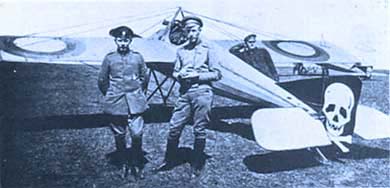 n.
n.
The British purchased a few Ns, which were used by Nos. 3 and 60 Squadrons, R.F.C., during the summer of 1916. The type became known as the 'Bullet' in the R.F.C.; it was armed with a Lewis gun. Ns were also supplied to the Russian l9th Squadron.
A captured Fokker monoplane (probably an E-III) and a 'Bullet' were flight-tested together in April 1916, and the Morane was found to have the better performance. It was not an aeroplane for a beginner, however, having a very high landing speed and extreme fore-and-aft sensitivity.
Some Monocoque-Morane's had strengthened undercarriages, modified cowlings and smaller spinners. The V and AC were 1916 developments; some thirty of the latter type were constructed, but it is doubtful if it formed the equipment of any operational unit. The wings were strut braced from below.
More about Rolland Garros, "the First Fighter Pilot"
World War I, often referred to as "the war to end all wars,"developed from the rivalry among European colonial powers which resulted from economic and political maneuvering. On June 28, 1914, a deranged Bosnian, Gavrilo Princip, murdered Archduke Ferdinand, heir to the throne of Austria-Hungary, and his wife, Sophie. Within weeks the continent of Europe was engulfed in a war which spread throughout Europe and into Africa and islands of the southwest Pacific.
The United States did not become actively involved until Germany began a campaign of unrestricted submarine warfare. This stirred America's conscience and on April 6, 1917, war against Germany was declared by President Woodrow Wilson.
At the outbreak of the war few nations had thought of using aircraft in aerial combat. Planes, however, were being used for bombing and spotting troop movements. Observation planes were unarmed. Pilots and observers did occasionally carry side arms or rifles, which were used with little or no success. On occasion they carried hand grenades, which were dropped on ground troops. They also frequently dumped iron flechettes, dart-like missiles, on ground troops. These were carried in containers under the fuselage and released with a triggering device in the cockpit.

Military aviation's role was changed forever with ideas generated by four men in the early months of the war. Three were Frenchmen, the other was Dutch. Two were civilians, two were pilots.
The two men who set the change in motion were Gabriel Voisin, civilian owner of the Voisin Aeroplane Works and Capitaine Andre Faure, an escadalle commander. His squadron was equipped with the Voisin planes which were monoplanes with a "pusher" style power system. The two men, without authorization, mounted Hotchkiss machine guns on tripods in order that they could be fired by the observer. To fire the guns, it was necessary to stand.
This original venture was not very successful at the outset but finally, on October 5th, 1914, a German observation plane was shot down. The French pilot was Joseph Franz, his observer and mechanic gunner was Louis Quenalt. Both men received decorations for their victory.
Now, the third man of the quartet, Roland Garros, a most unusual man for his time, enters our scenario. Garros was a polished man who was a virtuoso pianist as well as an accomplished aviator. Before the war he had won acclaim at international air meets and set an altitude record of 18,000 feet in December 1912. Roland Garros was also the first man to fly across the Mediterranean Sea, and he was also demonstration pilot for Morane-Saulnier Aircraft in the United States and, oddly enough, in Germany.
Roland Garros, who is remembered by France with a great tennis facility bearing his name, lost no time in offering his skills to the Seniced'Aeronautique. Famous as a pilot he was immediately assigned to an observation escadrille and made his first military flight shortly after he enlisted.
Garros was dissatisfied with gun arrangements on French combat aircraft. He immediately mounted a machine gun on his plane, but at an oblique angle to prevent propeller damage. This was a very unsuccessful attempt. Next he decided to mount the gun to f~re straight ahead, which meant through the propeller's arc.
On a visit to Paris, Garros voiced his frustration to Raymond Saulnier, of the Morane-Saulnier aircraft concern.
Saulnier had designed a mechanical device which would allow a machine gun to do what Garros wanted. The major problem was not with his idea, but with the design of the gun used. The Hotchkiss rate of fire was erratic, and the ammunition in use caused the gun to frequently hang-fire.
Saulnier invented a steel deflector unit to be fitted on the propeller, directly in the gun's line of fire. It was his contention that only a very small percentage of bullets would hit the protective shield, not enough to cause problems for the pilot.
 Garros took Saulnier's idea to a
mechanic friend, Jules Hue, who not only duplicated, but improved,
the deflector shield. The two men then mounted a Hotchkiss gun
on his Morane-Saulnier monoplane, the type aircraft he and his
squadron mates flew.
Garros took Saulnier's idea to a
mechanic friend, Jules Hue, who not only duplicated, but improved,
the deflector shield. The two men then mounted a Hotchkiss gun
on his Morane-Saulnier monoplane, the type aircraft he and his
squadron mates flew.
Garros took off for what was officially a bomb strike on a railroad yard on April 1, 1915. En route he spotted a German plane (Albatros or Aviatik, depend ing on resource data). Garros put his new armament to the true test. Climbing up under the aircraft, he opened fire. The German observer used a carbine, to return fire, but failed to do any damage. Using his plane to aim his gun, Garros quickly used two of his 25 shot trays of ammunition. While firing his final tray he saw the plane burst into flames, slowly spiral down, then smash into the ground.
On April 1, 1915, over 80 years ago, the first "Fighter Pilot" was born, The sight of this first fighter victory was somewhere between St. Pol, north of Paris, and Ostend(e), in Belgium, near the English channel. One account indicates it to be near a village called Dixude.
As a result of this victory and two more quick kills, he became a hero to France. His plane became the most feared plane in the French air service. He may, with his victories have established the bench mark of skill for later aces. But Adolphe Pequod is credited, in one history of the air war of World War I, as the first to reach the "ace" level, which has been used in following wars.
Unfortunately on April 18, while on a bombing mission Garros was shot down by ground fire and forced to land in German territory. Before he could destroy his aircraft, he was captured. The Germans, aware of his victories, seized the plane to determine what gave it it's fighting edge.
With Garros' quick success, as many Morane-Saulnier aircraft as possible were fitted with the deflector device. The supremacy of the skies was temporarily gained by the French. Germany in dire need of a quick fix, so to speak, turned to the Dutch aircraft entrepreneur, Anthony Fokker.
Fokker, a skilled pilot, was an aircraft designer and builder as well as a fine mechanical engineer. He was asked to duplicate the deflector on the Garros plane. Studying the fire control system he found, he decided it was an impractical method for firing a machine gun. Fokker decided it would be better to design a mechanism which would allow the gun to fire when the propeller was in a horizontal position.
In a reasonably short time, Fokker designed just such a mechanical system allowing a pilot to fire his machine gun from the cockpit by pressing a switch on the "joy stick." It was tested by Fokker and military pilots before acceptance.
Because of the efforts of four men, aviation, and especially military aviation, changed forever. What had been a somewhat gentlemanly affair to a great extent, became a bitter air dominance contest. This interest in air warfare most surely brought rapid improvement in design, and performance, of military aircraft.
While these changes were taking place, Garros was languishing in a German prisoner-of-war camp. After three years of internment, in 1918, he managed to make his escape. He made his way to France through Belgium and was again ready to take to the air. But, the role of wartime aviation had changed dramatically in his absence. This change was greatest in combat tactics; he was ordered to take a refresher course by the Service d' Aeronautique. When completed he was assigned to a fighter group (avions de chasse or planes of pursuit).
Tragically, in October 1918, Roland Garros, patrolling the front with another pilot, slipped away from his wingman and sped away. For some reason his wingman was unable to follow Garros, but did see a plane in the distance suddenly burst into flames and plummet to earth.
Roland Garros, a prime principal in initiating aerial combat, had flown his last flight.
Shortly after the news of Garros' death was made public by Dutch newspapers, his grave was found in the corner of a civil cemetery in the town of Vouziers, in northeast France some thirty miles from the German border. It was found when French troops entered the city. Five weeks after his death, the Armistice was signed.
The air victories of Roland Garros in 1915 did, indeed, deserve the credit they brought him. Under existing circumstances, they were quite an accomplishment. Fokker's invention of the gun firing system for man-to-man aerial combat, opened a Pandora's Box for all military pilots for evermore. During the World War I years, a great many young men became aces as they gallantly fought their air battles. Many ran up awesome scores of "kills." Yet, credit can be given to Roland Garros for being the first real fighter pilot.

Last week, as I was cleaning out my old pc, I found some business-card
models from Fiddlers Green.
Just finished building the Morane Bullet from it. The wingspan
is 62 millimeters..... Richard
Specifications for Morane-Saulnier N "Bullet"
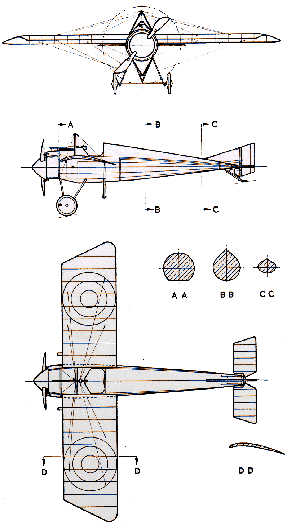 |
Length: 19 ft 1.5 in Wingspan: 26 ft 8.625 in Height: 7 ft 4.5 in Wing area: 118.4 ft² Empty weight: 633 lb Loaded weight: 976 lb Powerplant: 1× Le Rhone 9C air-cooled rotary engine, 80 hp Performance Maximum speed: 90 mph at ground level Service ceiling: 13,123 ft Endurance: 1 hr 30 min Climb to 6,560 ft: 10 min Armament Guns: 1 x .303 in (7.7 mm) Vickers machine gun or .31 in (7.9 mm) Hotchkiss |
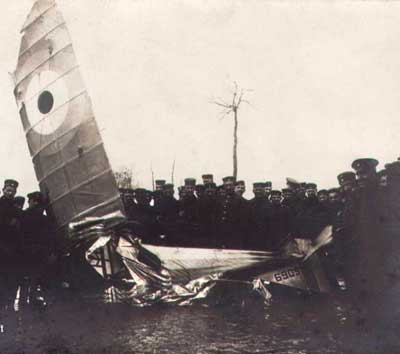 |
| No.1 Squadron Morane-Saulnier N 5069 of 2nd Lt. Ralph Pool Turner. Killed in action against Uffz. Groscher and Ltn. Patheiger March 9, 1916. |




